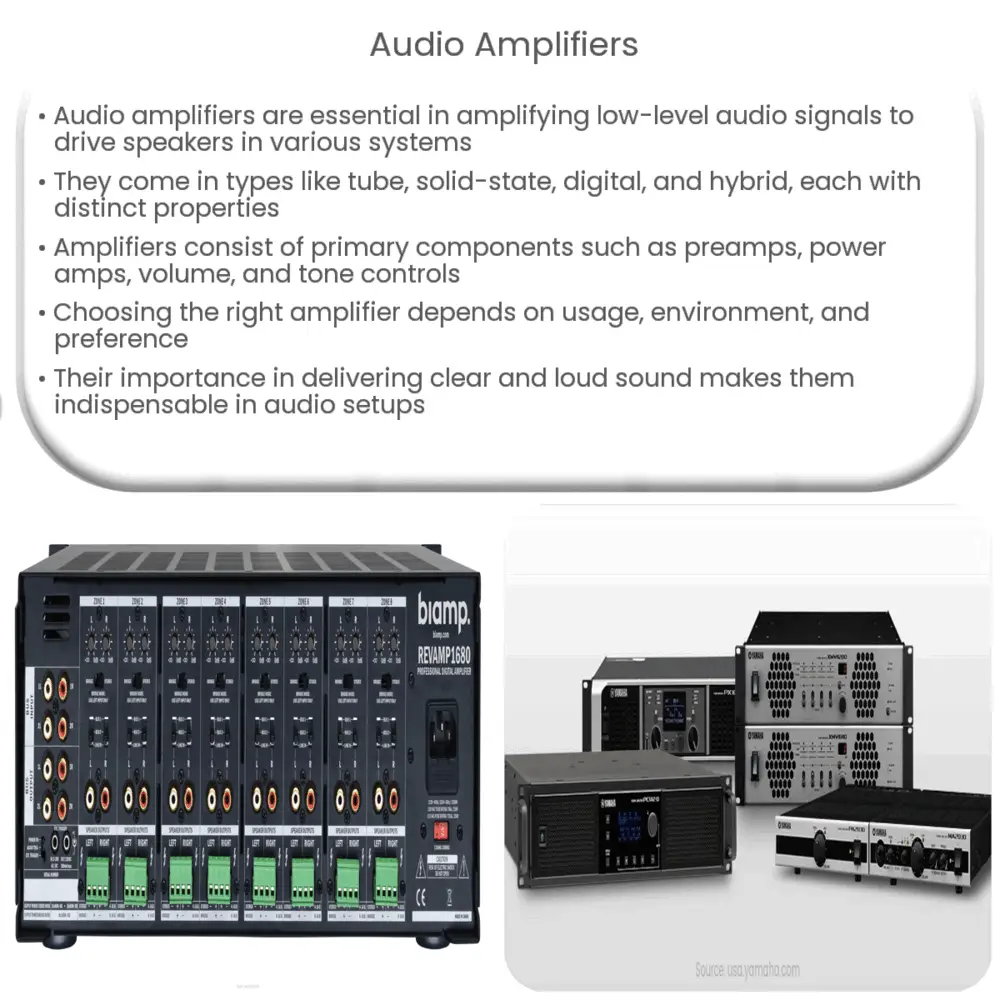Explore the world of audio amplifiers – their types, components, working principle, and significance in enhancing our sound experiences.

Introduction to Audio Amplifiers
Audio amplifiers are central to any audio system, including stereo systems, public address systems, and televisions. These crucial devices take a low-level audio signal and amplify it to a level that can drive speakers. In essence, audio amplifiers magnify the power of an audio signal, making it strong enough to move the cones in speakers to produce sound.
Types of Audio Amplifiers
There are several types of audio amplifiers, each with their unique properties, applications, and advantages. Understanding these types is key to selecting the right amplifier for your audio system.
- Tube Amplifiers: These are the oldest type of amplifiers and use vacuum tubes to amplify the audio signal. Despite being considered obsolete by some, they are still loved by audiophiles for their warm, smooth, and rich sound quality.
- Solid-State Amplifiers: These amplifiers use semiconductor devices like transistors to amplify the audio signal. They’re known for their reliability, longevity, and efficient power consumption.
- Digital Amplifiers: Also known as Class D amplifiers, they convert the audio signal into a digital representation and then amplify it. These are extremely efficient and produce less heat compared to other types.
- Hybrid Amplifiers: These combine the best features of tube and solid-state amplifiers, offering the warmth of tube amplifiers and the efficiency and reliability of solid-state amplifiers.
Components of an Audio Amplifier
An audio amplifier is not just a single component but a complex assembly of various elements. The primary components include:
- Preamp: This is the first stage in an amplifier, responsible for taking the low-level audio signal and preparing it for amplification.
- Power Amp: This takes the prepared signal from the preamp and magnifies it to a level that can drive speakers.
- Volume Control: It allows users to adjust the output level of the amplified signal.
- Tone Control: It adjusts the balance of high, mid, and low frequencies in the audio signal.
To understand the operations of an amplifier, it’s crucial to delve deeper into its working principles. So, let’s explore how an audio amplifier works in the next section.
How Audio Amplifiers Work
The primary function of an audio amplifier is to take a weak audio signal and boost its power so that it can drive speakers or headphones. The process starts with the preamplifier or ‘preamp’ stage, which prepares the signal for further amplification. It enhances the signal strength without distorting the audio quality, essentially preparing it for the power amp.
The power amp is the second stage of the process, where the real amplification occurs. It increases the current or voltage of the signal, depending on the type of amplifier used. The amplified signal then travels to the speakers, driving the movement of the speaker cones that generate the sound we hear.
Additional elements such as the volume control and tone control allow the user to adjust the output level and frequency balance, shaping the sound to personal preferences.
Importance of Audio Amplifiers
Audio amplifiers are of paramount importance in every sound system. They have a significant role in home audio systems, concert venues, recording studios, cinemas, and any situation where sound needs to be amplified for a better listening experience. They ensure that the sound delivered is clear, loud, and precise, regardless of the audio source.
Choosing the Right Audio Amplifier
Choosing the right amplifier is largely dependent on the intended use, environment, and personal preference. Factors to consider include the amplifier’s power output, the type of amplifier, the number of channels required, and the compatibility with existing audio equipment.
Conclusion
In conclusion, audio amplifiers are an essential piece of equipment in any audio system, making them indispensable in our daily lives. They play an integral role in converting low-power audio signals into a form suitable for driving speakers, thereby enriching our audio experiences. From vintage tube amplifiers loved by audiophiles to modern, efficient digital amplifiers, the world of audio amplifiers is diverse and continues to evolve with technological advancements. Whether you’re setting up a home theater system or a professional recording studio, understanding the basics of audio amplifiers can greatly enhance your audio setup and listening experience.



